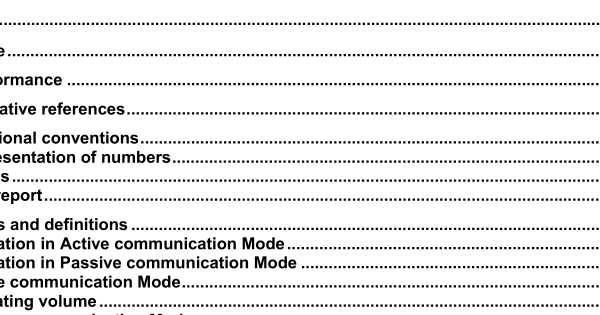ISO IEC 23917:2005 pdf download – Information technology — Telecommunications and information exchange between systems — NFCIP-1 — Protocol Test Methods.
4.3 Test report The test report includes the number of passed tests versus the total number of tests, the number of different samples and the date of the tests, see Annexes A and B. 5 Terms and definitions For the purposes of this document, the following terms and definitions apply 5.1 Activation in Active communication Mode flow to activate the DUT in Active communication Mode as defined in ISO/IEC 18092, which includes initialisation and protocol activation. 5.2 Activation in Passive communication Mode flow to activate the DUT in Passive communication Mode as defined in ISO/IEC 18092, which includes initialisation and protocol activation. 5.3 Active communication Mode in the Active communication Mode scheme, as defined in ISO/IEC 18092, both the Initiator and the Target use their own RF field to enable the communication. 5.4 Operating volume a volume with a field strength of at least H min and not exceeding H max generated by a NFC device at manufacturer specified positions. 5.5 Passive communication Mode the Initiator is generating the RF field and the Target responds to an Initiator command in a load modulation scheme as defined in ISO/IEC 18092. 5.6 Single Device Detection (SDD) SDD is an algorithm used by the initiator to detect one out of several Targets in its RF field. 5.7 Scenario a scenario is a protocol and application specific sequence test operations. Scenario description tables list all individual test operations. A horizontal line in a scenario description table indicates that the device shall be reset to initial conditions. 5.8 Test commands Commands defined for dedicated functional behaviour on an implemented system according to ISO/IEC 18092. The PDUs that are actually used in these commands shall be recorded in the test report (see Annex A and Annex B).
7 General description 7.1 Apparatus for Testing NOTE The test-apparatus may require information about the implemented protocol and functionality. These parameters shall be recorded in the test report. This clause is valid for Initiator and Target tests. Although this International Standard does not define dedicated test circuit for timing measurements and to check the correctness of the framing, influence of such circuit shall be avoided. 7.1.1 Generating the I/O character timing in reception mode The target-test-apparatus and the LT shall be able to generate the I/O bit stream according to ISO/IEC 18092. All timing parameters (e.g. start bit length, guard time, bit width, request guard time, start of frame width, end of frame width) shall be set to any value within the defined ranges of ISO/IEC 18092. The limits shall be tested according ISO/IEC 22536. 7.1.2 Measuring and monitoring the RF I/O protocol The targe-test-apparatus and the LT shall be able to measure the timing of the logical low and high states of the incoming demodulated data. 7.1.3 Test scenario and report Testing of the DUT as defined in this document and requires a test scenario to be executed. This test scenario contains a protocol and application specific sequence. The result of the test scenario shall be documented in a test report as defined in Annexes A and B. 7.1.4 RFU bits A test shall fail and the DUT declared non-compliant in case an RFU field is not set to its default value. 7.1.5 General rules The following rules apply: An Initiator (Target test apparatus) always sends a request whereas a Target (LT) sends a response.
ISO IEC 23917:2005 pdf download – Information technology — Telecommunications and information exchange between systems — NFCIP-1 — Protocol Test Methods






